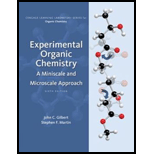
(a)
Interpretation: The structure of the major product formed from alkene indicated should be predicted.
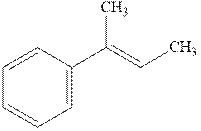
Concept introduction: Hydroboration-oxidation involves the sequence of two reactions. The hydroboration stage involves the treatment of alkene with diborane that generates alkyl borane. In second stage hydrogen peroxide in alkaline medium is used to oxidize the alkyl borane produced in step 1 that leads to the synthesis of alcohols from
Hydroboration is essentially the addition of
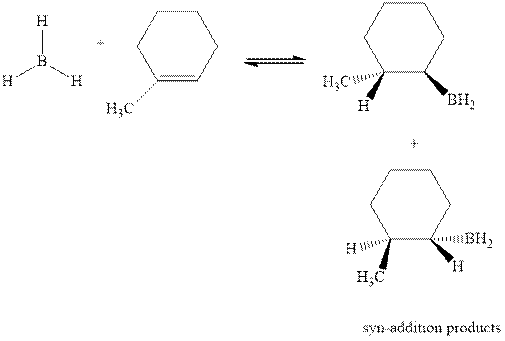
The mechanistic pathway can be illustrated as follows:
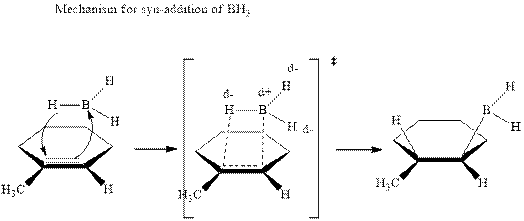
In the first step one equivalent of
(a)
Explanation of Solution
The hydroboration-oxidation productis illustrated as below.

Anti-Markovnikov’s Rule serves as the basis of hydroboration. It states that the negative part of reagent must go to the carbon that has fewer alkyl substituents or more
(b)
Interpretation: The structure of the major product formed from alkene indicated should be predicted.
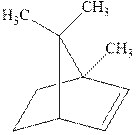
Concept introduction: Hydroboration-oxidation involves a sequence of two reactions. The hydroboration stage involves the treatment of alkene with diborane that generates alkyl borane. In second stage hydrogen peroxide in alkaline medium is used to oxidize the alkyl borane produced in step 1 that leads to the synthesis of alcohols from alkenes.
Hydroboration is essentially the addition of
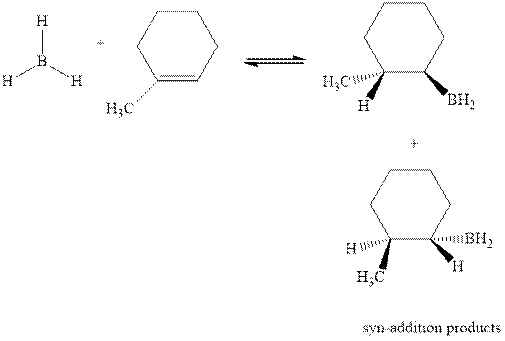
The mechanistic pathway can be illustrated as follows:
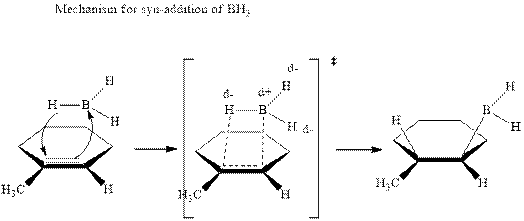
In the first step one equivalent of
(b)
Explanation of Solution
The hydroboration-oxidation product is illustrated as below.
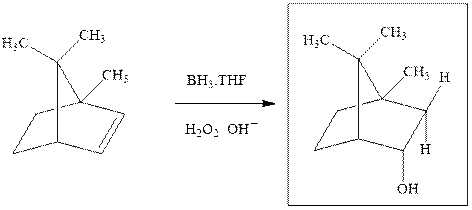
Anti-Markovnikov’s Rule serves as a basis of hydroboration. It states that the negative part of reagent must go to the carbon that has fewer alkyl substituents or more
(c)
Interpretation: The structure of the major product formed from alkene indicated should be predicted.

Concept introduction: Hydroboration-oxidation involves a sequence of two reactions. The hydroboration stage involves the treatment of alkene with diborane that generates alkyl borane. In second stage hydrogen peroxide in alkaline medium is used to oxidize the alkyl borane produced in step 1 that leads to the synthesis of alcohols from alkenes.
Hydroboration is essentially the addition of
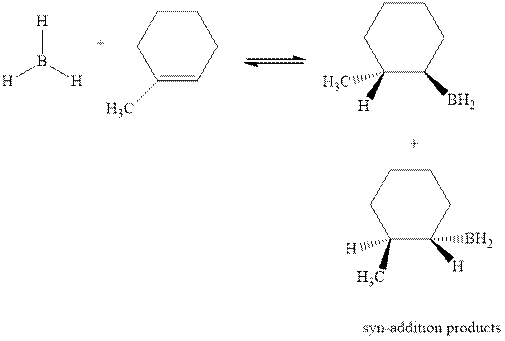
The mechanistic pathway can be illustrated as follows:
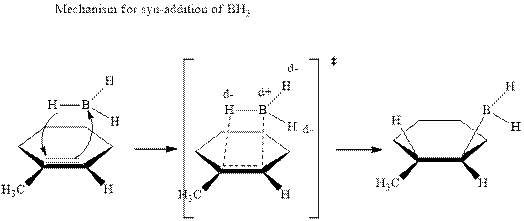
In the first step one equivalent of
(c)
Explanation of Solution
The hydroboration-oxidation product is illustrated as below.
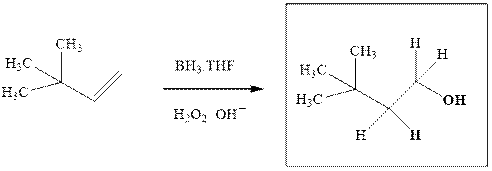
Anti-Markovnikov’s Rule serves as the basis of hydroboration. It states that the negative part of reagent must go to the carbon that has less alkyl substituents or more
Since the terminal olefinic carbon is less substituted
(d)
Interpretation: The structure of the major product formed from alkene indicated should be predicted.

Concept introduction: Hydroboration-oxidation involves a sequence of two reactions. The hydroboration stage involves the treatment of alkene with diborane that generates alkyl borane. In second stage hydrogen peroxide in alkaline medium is used to oxidize the alkyl borane produced in step 1 that leads to the synthesis of alcohols from alkenes.
Hydroboration is essentially the addition of
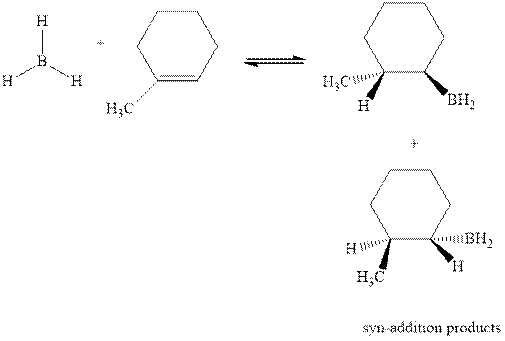
The mechanistic pathway can be illustrated as follows:
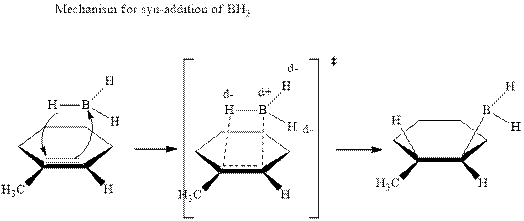
In the first step one equivalent of
(d)
Explanation of Solution
The hydroboration-oxidation product is illustrated as below.

Anti-Markovnikov’s Rule serves as the basis of hydroboration. It states that the negative part of reagent must go to the carbon that has less alkyl substituents or more
(e)
Interpretation: The structure of the major product formed from alkene indicated should be predicted.

Concept introduction: Hydroboration-oxidation involves a sequence of two reactions. The hydroboration stage involves the treatment of alkene with diborane that generates alkyl borane. In second stage hydrogen peroxide in alkaline medium is used to oxidize the alkyl borane produced in step 1 that leads to the synthesis of alcohols from alkenes.
Hydroboration is essentially the addition of
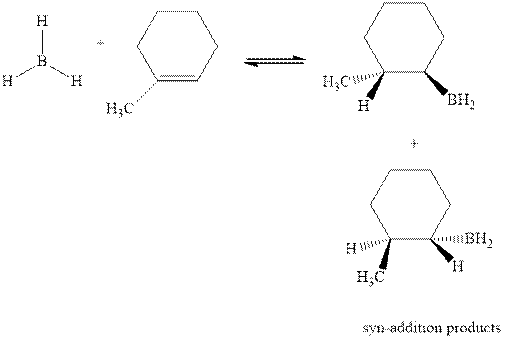
The mechanistic pathway can be illustrated as follows:
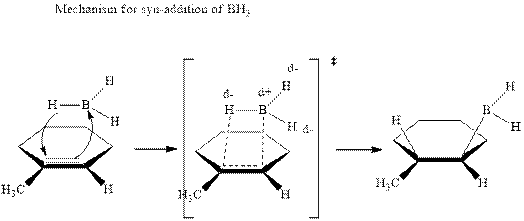
In the first step one equivalent of
(e)
Explanation of Solution
The hydroboration-oxidation product is illustrated as below.

Anti-Markovnikov’s rule serves as the basis of hydroboration. It states that the negative part of reagent must go to the carbon that has less alkyl substituents or more
Want to see more full solutions like this?
Chapter 10 Solutions
Experimental Organic Chemistry: A Miniscale & Microscale Approach (Cengage Learning Laboratory Series for Organic Chemistry)
- Calculate the pH and the pOH of each of the following solutions at 25 °C for which the substances ionize completely: (a) 0.000259 M HClO4arrow_forwardWhat is the pH of a 1.0 L buffer made with 0.300 mol of HF (Ka = 6.8 × 10⁻⁴) and 0.200 mol of NaF to which 0.160 mol of NaOH were added?arrow_forwardDetermine if the following salt is neutral, acidic or basic. If acidic or basic, write the appropriate equilibrium equation for the acid or base that exists when the salt is dissolved in aqueous solution. If neutral, simply write only NR. Be sure to include the proper phases for all species within the reaction. NaN₃arrow_forward
- A. Draw the structure of each of the following alcohols. Then draw and name the product you would expect to produce by the oxidation of each. a. 4-Methyl-2-heptanol b. 3,4-Dimethyl-1-pentanol c. 4-Ethyl-2-heptanol d. 5,7-Dichloro-3-heptanolarrow_forwardWhat is the pH of a 1.0 L buffer made with 0.300 mol of HF (Ka = 6.8 × 10⁻⁴) and 0.200 mol of NaF to which 0.160 mol of NaOH were added?arrow_forwardCan I please get help with this.arrow_forward
- Determine if the following salt is neutral, acidic or basic. If acidic or basic, write the appropriate equilibrium equation for the acid or base that exists when the salt is dissolved in aqueous solution. If neutral, simply write only NR. Be sure to include the proper phases for all species within the reaction. N₂H₅ClO₄arrow_forwardPlease help me with identifying these.arrow_forwardCan I please get help with this?arrow_forward
 Organic ChemistryChemistryISBN:9781305580350Author:William H. Brown, Brent L. Iverson, Eric Anslyn, Christopher S. FootePublisher:Cengage Learning
Organic ChemistryChemistryISBN:9781305580350Author:William H. Brown, Brent L. Iverson, Eric Anslyn, Christopher S. FootePublisher:Cengage Learning
